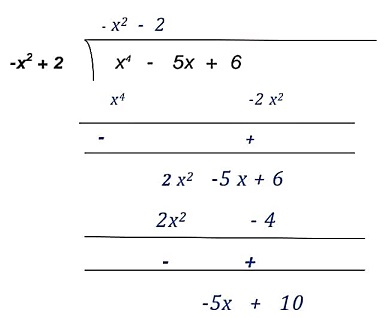Quick actions
Stay organised
Bookmark tricky proofs or add doubts to your dashboard so they resurface before exams.
Open dashboard →NCERT Solutions for Class 10 Maths Chapter 2 – Polynomials
Master "Polynomials" with step-by-step NCERT solutions.
Exercise 2.3
Question 1
Divide the polynomial p(x) by the polynomial g(x) and find the quotient and remainder in each of the following:
(i)p(x) = x3-3x2+5x–3 , g(x) = x2–2
(ii) p(x) = x4-3x2+4x+5 , g(x) = x2+1-x
(iii) p(x) =x4–5x+6, g(x) = 2–x2
Answer
(i)p(x) = x3-3x2+5x–3 , g(x) = x2–2
Here
Dividend = p(x) = x3-3x2+5x–3
Divisor = g(x) = x2– 2

we get,
Quotient = x–3
Remainder = 7x–9
(ii) p(x) = x4-3x2+4x+5 , g(x) = x2+1-x
Answer
Given,
Dividend = p(x) = x4 – 3x2 + 4x +5
Divisor = g(x) = x2 +1-x


we get,
Quotient = x2 + x–3
Remainder = 8
(iii) p(x) =x4–5x+6, g(x) = 2–x2
Answer
Given,
Dividend = p(x) =x4 – 5x + 6 = x4 +0x2–5x+6
Divisor = g(x) = 2–x2 = –x2+2

Therefore, upon division we get,
Quotient = -x2-2
Remainder = -5x + 10
Question 2
Check whether the first polynomial is a factor of the second polynomial by dividing the second polynomial by the first polynomial:
(i) t2-3, 2t4 +3t3-2t2-9t-12
(ii)x2+3x+1 , 3x4+5x3-7x2+2x+2
(iii) x3-3x+1, x5-4x3+x2+3x+1
Answer
(i) t2-3, 2t4 +3t3-2t2-9t-12
Given,
First polynomial = t2-3
Second polynomial = 2t4 +3t3-2t2 -9t-12

As remainder is 0. so we can say that, t2-3 is a factor of 2t2+3t+4.
(ii)x2+3x+1 , 3x4+5x3-7x2+2x+2
Answer
Given,
First polynomial = x2+3x+1
Second polynomial = 3x4+5x3-7x2+2x+2

As remainder is 0. so, we can say that, x2 + 3x + 1 is a factor of 3x4+5x3-7x2+2x+2.
(iii) x3-3x+1, x5-4x3+x2+3x+1
Answer
Given,
First polynomial = x3-3x+1
Second polynomial = x5-4x3+x2+3x+1

As remainder is not equal to 0. So, we say that, x3-3x+1 is not a factor of x5-4x3+x2+3x+1 .
Question 3
Obtain all other zeroes of 3x4+6x3-2x2-10x-5, if two of its zeroes are √(5/3) and – √(5/3).
Answer
√(5/3) and – √(5/3) are zeroes of f(x).
so
(x –√(5/3) (x+√(5/3) = x2-(5/3) = 0
(3x2−5)=0, is a factor of given polynomial f(x).
Now,

Therefore, 3x4 +6x3 −2x2 −10x–5 = (3x2 –5)(x2+2x+1)
On further factorizing (x2+2x+1) we get,
x2+2x+1 = x2+x+x+1 = 0
x(x+1)+1(x+1) = 0
(x+1)(x+1) = 0
So, its zeroes are given by: x= −1 and x = −1.
Therefore, all four zeroes of polynomial equation are:
√(5/3),- √(5/3) , −1 and −1.
Question 4
On dividing x3-3x2+x+2 by a polynomial g(x), the quotient and remainder were x–2 and –2x+4, respectively. Find g(x).
Answer
Given,
Dividend, p(x) = x3-3x2+x+2
Quotient = x-2
Remainder = –2x+4
we know,
Dividend = Divisor × Quotient + Remainder
∴ x3-3x2+x+2 = g(x)×(x-2) + (-2x+4)
x3-3x2+x+2-(-2x+4) = g(x)×(x-2)
Therefore, g(x) × (x-2) = x3-3x2+x-2
g(x) =
Therefore, g(x) = (x2–x+1)
Question 5
Give examples of polynomials p(x), g(x), q(x) and r(x), which satisfy the division algorithm and
(i) deg p(x) = deg q(x)
(ii) deg q(x) = deg r(x)
(iii) deg r(x) = 0
Answer
(i) deg p(x) = deg q(x)
We know
Dividend = Divisor × Quotient + Remainder
∴ p(x) = g(x)×q(x)+r(x)
Where r(x) = 0 or degree of r(x)< degree of g(x).
(i) deg p(x) = deg q(x)
Answer
Degree of dividend is equal to degree of quotient, only when the divisor is a constant term.
Let us assume an example, 6x2+6x+6 is a polynomial to be divided by 3.
p(x)= 6x2+6x+6g(x)= 3
So, (6x2+6x+6)/3 = 2x2+2x+2 = q(x)
so we can see, the degree of p(x) and q(x) is equal.
Hence, division algorithm is satisfied here.
(ii) deg q(x) = deg r(x)
Answer
Let us p(x)=x4+x
g(x)=x3.
So, (x4+x)/x3 = x = q(x)
Also, remainder, r(x) = x
we can see, the degree of q(x) and g(x) is equal .
Hence, division algorithm is satisfied here.
(iii) deg r(x) = 0
Answer
Let us take an example, p(x) = x3+1 is a polynomial to be divided by g(x)=x.
So,( x3+1)/x= x=q(x)
And r(x)=2
Clearly, the degree of remainder r(x) is 0.
Hence, division algorithm is satisfied here.
Chapter shortcuts
- Chapter 1 · Real Numbers
- Chapter 2 · Polynomials
- Chapter 3 · Pair of Linear Equations in Two Variables
- Chapter 4 · Quadratic Equations
- Chapter 5 · Arithmetic Progressions
- Chapter 6 · Triangles
- Chapter 7 · Coordinate Geometry
- Chapter 8 · Introduction to Trigonometry
- Chapter 9 · Some Applications of Trigonometry
- Chapter 10 · Circles
- Chapter 11 · Constructions
- Chapter 12 · Area Related to Circles
- Chapter 13 · Surface Areas and Volumes
- Chapter 14 · Statistics
- Chapter 15 · Probability